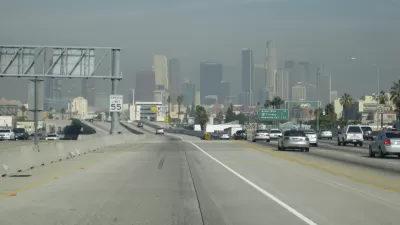In what could be viewed as a classic environmentalist vs. business showdown, the EPA tightened by 20% the annual standard for soot over the objection of industry and some in Congress who fear it will dampen economic growth.
Meeting the court deadline to update regulations on fine particulate matter, also know as PM 2.5, the Environmental Protection Agency (EPA) tightened the current standard by 20%; a move that will affect both stationary emitters, e.g. power plants and mobile emitters, e.g. diesel vehicles, locomotives, ships. EPA released the new regulation on the deadline imposed upon them by the courts. The regulation is designed to reduce premature deaths and respiratory and cardiovascular problems caused by soot "which reaches deep into the lungs and enters the bloodstream."
Ben Geman writes that the "agency unveiled final rules on Friday that ratchet down the annual exposure standard to 12 micrograms per cubic meter, a 20 percent reduction from the current standard of 15 micrograms."
“We know clearly that particle pollution is harmful at levels well below those previously deemed to be safe. Particle pollution causes premature deaths and illness, threatening the millions of Americans who breathe high levels of it,” said Norman H. Edelman, the chief medical officer for the American Lung Association (ALA).
Industry groups were upset with the decision and warned that it would "thwart economic growth".
“This new standard will crush manufacturers’ plans for growth by restricting counties’ ability to issue permits for new facilities, which makes them less attractive for new business. Essentially, existing facilities will have to be shuttered for new facilities to be built in these areas,” National Association of Manufacturers (NAM) CEO Jay Timmons said in a statement.
The charge was disputed by the EPA that said that "existing EPA and state initiatives will ensure that most regions would be able to meet the new fine particulate matter requirements". In fact, they estimate that "99% of U.S. counties [are] already in compliance with the new standard." A major exception will likely be California (see below).
The EPA press release noted that because it is an annual standard that was set on Friday, the new standard would have "no effect on the existing daily standard for fine particles or the existing daily standard for coarse particles (PM10)."
"EPA plans to make designations about which counties aren't in attainment with the rules by the end of 2014, and states must provide implementation plans to EPA in 2018. States must come into compliance in 2020."
Effect on California: Los Angeles, Inland Empire and Central Valley likely to be out of compliance by 2020 - will need to further restrict diesel emissions.
Neela Banerjee of the Los Angeles Times explains why the new annual standard will impact transportation in areas already impaired by high PM pollution.
"According to the EPA's regional office of the Pacific Southwest, seven California counties may not meet the new standard by 2020: Los Angeles, Riverside, San Bernardino, Imperial, Kern, Merced and Tulare.
Paul Cort, a California-based lawyer with the environmental law and advocacy group Earthjustice, said in an email, "We don't have coal power plants in California. The big targets will have to include transportation — trucks, ports, trains — but even that will probably not be enough. These areas are going to have to really look across all industries to find the pollution reductions."
FULL STORY: EPA orders tougher limits on soot

Study: Maui’s Plan to Convert Vacation Rentals to Long-Term Housing Could Cause Nearly $1 Billion Economic Loss
The plan would reduce visitor accommodation by 25,% resulting in 1,900 jobs lost.

North Texas Transit Leaders Tout Benefits of TOD for Growing Region
At a summit focused on transit-oriented development, policymakers discussed how North Texas’ expanded light rail system can serve as a tool for economic growth.

Using Old Oil and Gas Wells for Green Energy Storage
Penn State researchers have found that repurposing abandoned oil and gas wells for geothermal-assisted compressed-air energy storage can boost efficiency, reduce environmental risks, and support clean energy and job transitions.

Santa Barbara Could Build Housing on County Land
County supervisors moved forward a proposal to build workforce housing on two county-owned parcels.

San Mateo Formally Opposes Freeway Project
The city council will send a letter to Caltrans urging the agency to reconsider a plan to expand the 101 through the city of San Mateo.

A Bronx Community Fights to Have its Voice Heard
After organizing and giving input for decades, the community around the Kingsbridge Armory might actually see it redeveloped — and they want to continue to have a say in how it goes.
Urban Design for Planners 1: Software Tools
This six-course series explores essential urban design concepts using open source software and equips planners with the tools they need to participate fully in the urban design process.
Planning for Universal Design
Learn the tools for implementing Universal Design in planning regulations.
Ascent Environmental
Borough of Carlisle
Caltrans
Institute for Housing and Urban Development Studies (IHS)
City of Grandview
Harvard GSD Executive Education
Toledo-Lucas County Plan Commissions
Salt Lake City
NYU Wagner Graduate School of Public Service



























